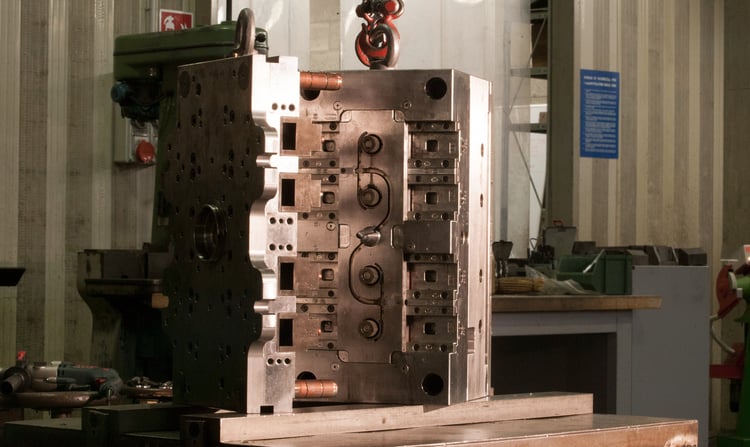As winner of numerous international awards, Bruschi Spa is known for its innovative approach in design and technology. We are glad to share our insights and experiences with the industry members.
Defects in die casting fixable thanks to the Tool Shop
In this post we are going to discuss some of the most common defects in die casting linked to mold maintenance, and how they can be fixed by the maintenance department.

Typical defects in die casting production can be caused by many different factors: some of them can be avoided by using a simulation software, while others are linked to machineries’ issues or mold anomalies.
The second kind of defects can be solved thanks to an advanced maintenance department with complex analysis and tailored solutions: that is one of the reason why having a Tool Shop located in close proximity with the production area is a great advantage.
Specifically, the most common defects that can be solved by the maintenance department are:
- Burr
- Surface erosion
- Sticking
- Gripping
- Broken plugs
In the post below, each of these defect is going to be described, starting from their definition up to their solving.
Burr
Burrs are among the most frequent defects in die casting. They are caused by a material overflow from the die casted shape borders. Burrs presence is both unaesthetic and dangerous, for example it can cause short-circuit in electronics, or it can cause slight injuries to the workers handling the metal pieces through the production process.
Usually burr formation is due to an irregular closure of the mold. This is caused by either a lack or an excess of material on one side of the mold, an imperfection linked to an error in mold building or, more often, it can be the result of a damage occurred during the casting.
In order to solve this critical issue the standard resolving method involves the use of a CNC machine, which enables a precise processing of the contact surfaces. Sometimes to identify the most critical zones an analysis with a mold-trial press needs to be run, by using a Prussian blue dye to highlight the . Thanks to this method it is possible to identify the contact point of the mold, and to proceed with the necessary adjustments by adding or removing material with a laser welding.
Surface Erosion
Surface erosion is the removal of steel particles from the impression surface, and it is mainly caused by excessive speed and excessive flux turbulence during the injection phase. The maintenance department usually solve this issue by welding or by using dowels on the problematic zone. This method allows for a rapid recovery of the productive process, since the molds can be fixed quickly.
Sticking
The term “sticking” identifies an alloy deposit on the die walls due to an electrochemical reaction between the casted Zamak and the steel walls of the mold, which leaves clear traces on the pieces, such as stripes or excessive surface roughness. In this case it is necessary to work directly on the mold, restoring it to its original status through an ultrasonic cleaning of the matrices or, more frequently, through a mechanical removal of the alloy deposit. Independently from the chosen solution, having a Tool Shop close to the foundry accelerates the repair process and helps avoiding long machines stops.
Gripping
Gripping is the stall of two solid surfaces that scrape one against the other, creating friction between two pieces. In die casting, gripping concerns mainly the extractors and more generally all the moving parts of the mold. Usually the moving parts are made of materials with a different hardness than their sliding rails so as to avoid gripping.
Nevertheless, wrong tolerances in the passing holes, excessive temperatures or a lack of lubrication of the mold in production phase can cause gripping. To sum up, this problem can show up in case of a mistake in mold design, in mold production or bad upkeep in production or storage. In these cases the tool shop can intervene and fix the issue by restoring the damaged surfaces, by improving the hardness with nitriding or rebuilding the deteriorated parts.
Broken Plugs
In die casting industry, the term plug identifies small-sized cylindrical shapes that are used for making small cavities in the casting. Plugs are fundamental mold components and in some cases they can be very fragile, given their size, and are subjected to many strains such as overheating, compression, traction and other deformations that can damage their integrity. For some projects an extraordinary maintenance can be planned, so as to avoid the breakage of these small elements and avoid delays in products delivery.
The previously exposed issues are among the most common deriving from anomalies in molds. Although this is not a complete list, it clearly shows how an up-to-date and experienced maintenance department can prove essential in accelerating the fixing process. Whether the problem is a common one or an unusual one, the Tool Shop along with the maintenance department can help solve them and gain new experiences from them.
The cases analyzed in the Tool Shop can produce important data. In fact, this process is very useful not only to find a quicker solution for the defects in die casting, but sometimes they also offer inputs for the prevention or the removal of the issue in mold designing phase. Recurrent problems often have the same cause, which can be prevented and dealt with in mold design phase. This kind of solution can increase the whole production capacity.
All of this increases the knowledge of the product and the processes both in the maintenance department and in the whole plant, making the production process faster and avoiding wastes of time and resources by reducing occurrences of defects in die casting.
To always be up-to-date with latest news in die casting, subscribe to our blog.
